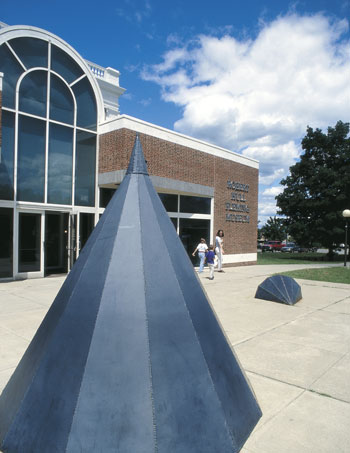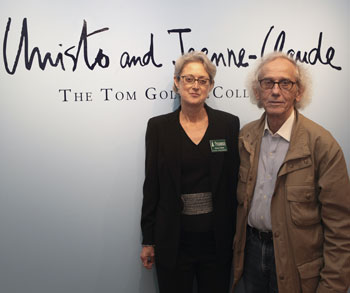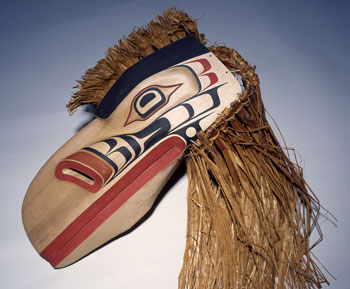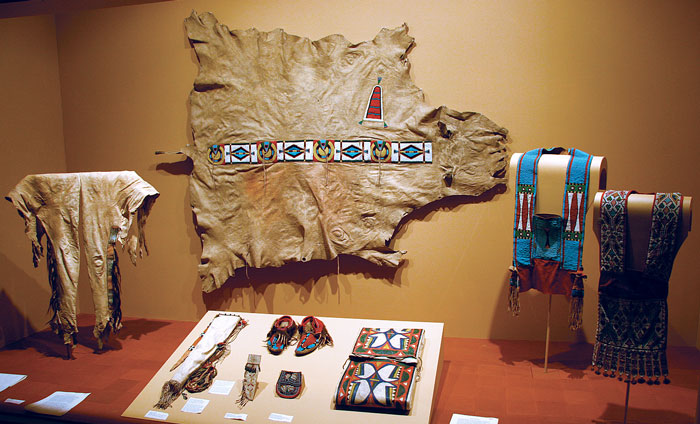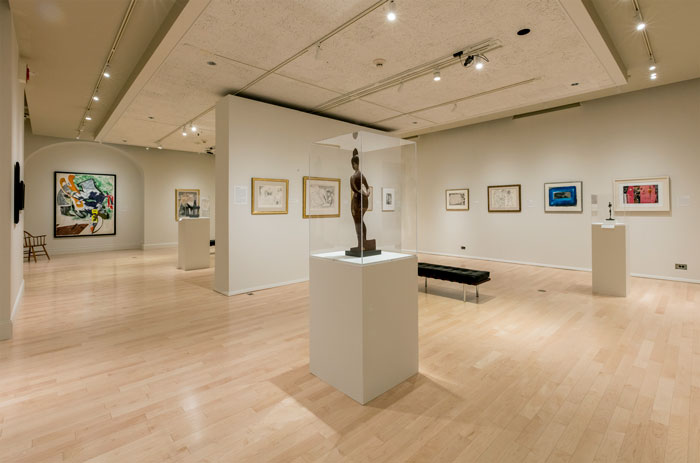Janie Cohen: The Fleming Museum’s Longtime Director Reflects |
|||
Director Janie Cohen photo: Jan Doerler |
In her three decades in the museum world, in work that has taken her around the US and Europe, Janie Cohen, published Picasso scholar and director of the University of Vermont’s Fleming Museum of Art, has both effected, and been affected by, a shift in how museums serve their patrons. “To see this, you just need to look at the mission statements of museums over the years,” says Cohen. “Where once the focus was exclusively ‘collect, conserve and interpret,’ now the conversation is, ‘Who are we doing this for, and why are we doing it?’” “Once I got to know the collection,“ Cohen says, “I felt the way it was installed did not reflect its strengths.” Cohen thought it eurocentric and wanted to bring out more of the Native American and non-Western pieces. “I wanted a broader access that would serve the public, the university students, and grades K through 12 who were coming for education,” Cohen says. Cohen achieved this by combining European and American art into one gallery, with ancient, Egyptian, and African occupying another, which freed up the Native American collection to have its own space. The change took about nine years, while the museum remained accessible throughout. |
||
David Carris served on the Vermont Arts Council around the same time Cohen came on board and now is on the Fleming’s advisory board. Carris believes it is Cohen who helped form the Fleming’s present identity, a museum known for a cultural diversity that belies its size. “Like many university museums, who [do] you serve, are [your collections artistic or anthropological] become questions when there is a collecting impulse of stuff. Janie broke down all those walls and made the questions completely moot, by using this great repository of material cultures, art, and artifacts as a springboard to talk about the many histories. What I see now coming back is a museum that is really clear about mission, focus, and who it serves.” Whom the Fleming serves is a range of genders and cultures that seek to be heard, seen, and represented in today’s world. Cohen is keenly aware of this and says, “In society, there is a movement from the cultural gatekeepers, publishers, and curators telling the public what they should be seeing or reading to a much more participatory, crowd-sourced framework. “ |
|||
photo: courtesy Fleming Museum |
An early example of Cohen’s participatory approach was her invitation to artist Michael Oatman to curate an exhibit in 1995 on the eugenics movement in Vermont, entitled: ”Long Shadows, Henry Perkins and the Eugenics Survey in Vermont.” In the show, Oatman drew from the museum’s collection to tell the disturbing story of eugenics in Vermont. Eugenics, or compulsory sterilization, was comprised of two-thirds women, with people of Abenaki, African American, and French Canadian heritage. Indicative of Cohen’s openness to help retell history was that Henry Perkins was the Fleming’s first director. An online tour of this exhibition is available online. Oatman relates via e-mail, “In 1994, when Janie asked me to create a show from the Fleming’s collection, it was unusual for an artist to be tapped as a curator, but not unprecedented. Artist Fred Wilson had just performed the same task at The Contemporary in Baltimore, where Lisa Corrin asked him to look critically at the holdings of the Maryland Historical Society. That show was a game changer, because it regarded the act of curating as a display of power, authority. It asked, ‘Who decides what gets into museum collections, and what goes on view?’ It asked crucial questions about whose story was being told, and in what voice.” |
||
More recently, Cohen looked to Vermonters to help tell another story, that of Lake Champlain. The museum’s quadricentennial celebration of Lake Champlain in 2009, “Treasures and Tales: Personal Connections to the Lake,” displayed lake-related objects and photos of personal importance to Vermonters, accompanied by their own written descriptions. “When you think about objects and images,” Cohen says, “they are very connected to our emotional and private lives, and the things that mean the most to us.” Through the years, Cohen has invited the University of Vermont community, including students, to curate shows at the Fleming. The Native American collection was curated by different staff and faculty and includes representation from different tribal groups. “It enriches the story,” Cohen says.
“The demographics of the nation are changing. We are becoming a browner, more diverse country,” says Dr. Gretchen Sorin, professor of museum studies at SUNY at Oneonta. Sorin, who writes and lectures on African American history and museum practice, says, “As the repositories of the cultural patrimony of the country, the choices that museums make about whose history is important, what stories to tell, and whose objects and art to preserve is a not-so-subtle message about what and who is important. For decades, the message has been a singular one for African Americans, Native Americans, Latino Americans, and even women—your story is not important. Now museums are playing catch up.” Cohen points out that in donor development there has always been an acquisition focus at the Fleming, and for many years, it was to increase the work of women and artists of color. It is important to Cohen that the acquisitions are not only historical but contemporary, as she says, “This is a living culture.” |
|||
But not all museums are there yet. According to Kay WalkingStick, Native American artist since the ’60s, mainstream museums can do better in representing Indian people and women artists. “Certainly the field has opened to women, but there are precious few Native American artists shown in those same museums. Indian artists are still primarily shown in ethnic shows and ethnographic museums. Change is slow. More curators need to step up to the plate and be inclusive as Janie Cohen has been." (WalkingStick’s work can presently be seen at the Fleming, on her website, and in a large retrospective at the National Museum of the American Indian at the Smithsonian, until September 18.) Cohen wants to push another boundary, that of the use of technology to engage and evoke emotions. “Historically, museums are a place where people whisper, as in libraries,” says Cohen. |
Raven headdress made by Tony Hunt, 2001 |
||
“When I see that happening in the Fleming, I don’t want people to feel they have to whisper.” Previously she had only dipped her toe into technology, Cohen explains, with student-recorded iPod art tours and medieval recordings from the music department. Thanks to technology, the Picasso exhibit was the most immersive the museum had been. Some of the installations included sounds evoking a walk from Picasso’s studio, a recording of actors voicing Picasso’s inner circle, and a projection of Demoiselles using augmented reality, through the lens of available iPads or the visitor’s smart phone.
Karson writes via e-mail, “The materiality of our culture and how we interact with the everyday world has changed dramatically in the last 20 years. You see trends in society where people want experiences, more than objects, at this time in history. Many artists want to work with that as well, creating experiences that captivate and engage the audience.” Karson writes that Cohen not only provided guidance and vision for the show, but an openness to risk taking, which allowed her and Brownell “to bring what we had to the table.”
During her long career, Cohen has left an impression on artists, professors, and students. Oatman writes that the “Long Shadows project established my working methods for the next 26 years. For example, it was during this time that I began to look a great deal before setting on a particular conceptual path. I visited the collection for six months before the right project emerged. Also, the decision to eliminate wall labels and didactic texts came out of this process at the Fleming. Finally, the amount of press generated by the political controversies led to many other ‘museumist’ projects. It was a springboard to a career.” Mary Jane Dickerson, with UVM since 1966 and now a professor of English emerita and a Fleming board advisor, appreciates Cohen’s attention to Dickerson’s favorite subject, literature. “I saw early that Janie was more in tune with what was going on in academic world,” says Dickerson. “The museum showed an awareness of the expansion in literature canon, more women, writers of color—and was more a place where I could take students with exhibits that complemented courses.” UVM alumni Mateus Teixeira graduated with a degree in math and physics but craved the peace he found at the Fleming. Texeira says via phone from NYC, where he is e-book production manager at W.W. Norton & Company, “I went to the Fleming to rest and tune out during college. After I graduated, I e-mailed Janie on a whim to see if there was any way I could help at the museum” As Cohen was in need of a curator, Teixeira interned for six months and worked on three shows with her, including the Picasso exhibit and the Dorothy and Herb Vogel show. He remains friends with Cohen, is on the museum’s advisory board as an alumni, and says of Cohen, “Janie is gracious and generous, not reserved and standoffish as some museum directors I have found to be.” And, Barbara Zucker, sculptor and UVM professor of art emerita, sums up her view of Cohen’s career at UVM, “She has weathered the uncertain seas of academia—not quite of it but committed to it. First as curator, and subsequently as director of the Fleming, Janie has kept her own scholarship alive. She has generated financial gifts and acquisitions to the museum and continues to curate her own exhibits that are compelling and timely.” And in case there was any doubt as to her greatness, one more word or two from Oatman: “In an era of generalist curators (not a bad thing), Janie is a notable curator/museum director in that she has continued her graduate school research into Picasso. It is a driving force that has shaped her worldview. By loving a subject, such as Picasso, one is able to get excited about discovery, which is what artists and curators do for us—as viewers, anyway. So, from that immersion into Picasso, Janie has been able to understand what gets viewers excited about learning: the encounter, the quest, the revelation. It is what lets her be equally excited about local visionaries as well as artists from outside the Americas. About ancient objects and the latest technology.” |
|||
photo: courtesy Fleming Museum |
|||
|
I asked Cohen to reflect on her own creative and professional evolution. Her response, “The role of my creativity has expanded from curating exhibitions to all that I do now: from thinking about innovative ways that the museum can better serve its mission, to how best to support and inspire my staff, to how to give back to the museum field. Some of the most exciting work I’ve done recently is in thinking with colleagues, regionally and nationally, about the future of museums. “This greater ease has also erased some previous boundaries I had drawn. My creative writing, which had never engaged the history of art, has now bumped up against my scholarly writing, exemplified by a fictional piece on Picasso I wrote for our 2015 exhibition catalogue Staring Back, based on new scholarship I had published in a refereed journal last year. “I could sum up my professional and creative evolution over the past 25 years as a steady convergence that has enriched all aspects of my work. I am grateful to be able to work in the museum field, and particularly to be doing so in Vermont. I can honestly say that I am enjoying my work now more than ever!”
|
|||
|
Roberta Nubile is a freelance writer out of Shelburne, Vermont. Favorite topics: inspiring people, projects, and events.
|
||
350px_WEB.jpg)
